One of the challenges as a prototype modeler is deciphering what commodities traveled on the railroad that I model and from where they came or were going to. So far, my only clues are the venerable B&O Form 6 (a document which outlines sidings and businesses that they served, yet is not complete considering there were team track yards, shared trackage, etc.), photographs and some maps & diagrams which offer up clues. There are documents buried in various archives waiting to be uncovered but that’s another story. For now, I run with what I have.
An excellent HABS/HAER document from the Library of Congress outlines the history quite nicely. Dalecarlia existed as a reservoir beginning in the mid 1850s, which received water from the Washington Aqueduct. The water treatment plant was built ca 1922 to help meet the growing population. DC began adding chlorine to its drinking water in 1923 and the Dalecarlia rapid sand filter came online around 1927 and used sand and aluminum sulfate to clarify the water. In 1928 the chemical building/head house was constructed, including a five-story tower which stored additional chemicals; alum, bauxite, lime and more. Likely, the B&O’s relatively new branch line provided a conduit for construction materials and consumables/chemicals for the construction and initial operations there. (Kelly and I uncovered what I believe to be an old siding where there was some sort of unloading device or construction facility astride one of the ponds, in the very northwestern tip of the facility.) Early photos indicate that the B&O had merely a short siding there for many years.


At some point, the B&O built a yard and an unloading system In a photo from 1947, I can see the unloading tanks which is the earliest photographic representation I have. An aerial photo from Historic Aerials shows the facility in 1949.

In a photo from 1956 shot by Ray Mumford, we get the best view I have of the yard and facilities. Note the overhead pipe bridge.

Thankfully, the B&O documented the construction of this overhead bridge:

The plan indicates that this bridge was constructed in 1952, perhaps replacing or upgrading an earlier structure; I have no photos to determine this, yet. Here is a detail of the pipe bridge cross-section:

So back to our original question about commodities. This cross-section has labels on the pipes, indicating what they were used for. Nice! We see: sulfuric acid, carbon, “elec.” (electrical?), air (compressed?), sulfur dioxide and two chlorine conduits. Combined with the information found above – sand, aluminum sulfate, alum, bauxite, lime, etc. – we start to get an even better picture of what arrived at the water treatment plant via the B&O. This helps me to hone in on freight cars and operational schemes for my layout which is a crucial thought exercise for planning what cars I want to model and what purchases I want to make for my fleet.
I still have so many unanswered questions – like what did the plant look like in the 1940s? What were the chemicals used for? What was stored where? How did the unloading facility work, exactly? What shippers sent cars to the reservoir and what rolling stock was used. Someone once mentioned seeing a “chlorine train” going down the branch with a few cars. Did the B&O have a dedicated train for chlorine on the Georgetown Branch? This offers an interesting operational possibility, if true. These fine details are what run through my head as I compile this information and seek answers and solutions. For now, I’ll have to go with what I have. We’ll probably go in a bit deeper later on some other speculation and theorycrafting, but until then, enjoy this photo of a train at Georgetown Junction that includes a chlorine car from Westvaco in WV:

My copy of the 1954 ORER indicates 12 cars for Westvaco, with reporting marks WVCX. By 1959 I am sure they had more but I need to get my hands on an ORER for that year. Onward!
Is that Westvaco chlorine car on the sidings at Georgetown Junction or the mainline on a passing freight?
I recall the chlorine tanks at DaleCarlia. They stopped shipping by rail in 1979. After the streetcar was ripped up they built an entirely new network of sidings – 2 tracks for chlorine, a runaround and two more tracks.
I remember gray tankcars of approximatly 10,000 gallons (just like that westvaco car). I was too young then to be fully conscious of roadnames (I got the big ones like B&O, but not private owners). I think that I may have seen Diamond Chemical tanks cars in there, but I may have also conflated my memory with the Tyco tank car that my mom gave me to represent the traffic in there. There would often be two tank cars there at once, but I have the idea there wasn’t that much traffic in total, so the cars might have sat there awhile.
I toured the plant around 1980. At that time they talked about using sand and charcoal to filtrate the water (some ponds used one material, others the other – depending on the year they were built). Sand and bauxite and lime are all consistent with the 2 bay covered hoppers in the picture. Could the sand come from Smoot Sand & Gravel? I have no idea.
I got curious and started googling.
I found a 1955 report: https://pubs.usgs.gov/wsp/1299/report.pdf
It says they used 7 parts per million of chlorine. At that time the capacity of Dale Carlia Filtration plant was 100 million gallons a day. Google says capacity is now 150 million gallons a day. In 1980 the plant had been expanded not that many years prior (I think perhaps after 1960) so perhaps that is when the expanded capacity began?
So . . . if the plant was running full tilt (which I assume it wouldn’t be), it would be using 700 or 1,050 gallons a day. So more or less 1 chlorine tank car every 10 days. Which seems about right to me.
Christopher – The tank car is on the westbound main on the Met. Without speaking to the photographer, I can’t be sure, but the image is from a few photos showing what I think is the Georgetown switcher at the Junction, presumably switching the team tracks for the local to pick up. I think there’s a shot of a GP7 picking them up as well. Have a look here: https://www.flickr.com/photos/cpl_clegg/albums/72157661477078718
Thank you for your recollections! These help to fill in some holes for me. I will add it to my notes. I have only seen one photo of the “new” track arrangement at the facility, posted to Facebook. I will post it to the blog shortly! Here is a link to the Facebook page (I think membership is required): https://www.facebook.com/groups/122175894510427/permalink/2290355931025735